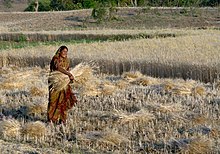
Back المرأة في الهند Arabic ভারতে নারী Bengali/Bangla ژن لە ھیندستان CKB زنان در هند Persian Naiset Intiassa Finnish Condition des femmes en Inde French ભારતમાં મહિલાઓ Gujarati भारत में महिलाएँ Hindi Žene u Indiji Croatian Wanita di India ID
 A woman harvesting wheat in Raisen district, Madhya Pradesh, India | |
| General Statistics | |
|---|---|
| Maternal mortality (per 100,000) | 112 |
| Women in parliament | 14.5% |
| Women over 25 with secondary education | 41.8% [M: 53.6%] |
| Women in labour force | 27.2% [M: 78.8%] |
| Gender Inequality Index[1] | |
| Value | 0.490 (2021) |
| Rank | 122nd out of 191 |
| Global Gender Gap Index[2] | |
| Value | 0.629 (2022) |
| Rank | 135th out of 146 |
| Part of a series on |
| Women in society |
|---|
 |
The status of women in India has been subject to many changes over the time of recorded India's history.[3] Their position in society deteriorated early in India's ancient period, especially in the Indo-Aryan speaking regions,[a][4][b][5][c][6] and their subordination continued to be reified well into India's early modern period.[d][7][4][5]
During the British East India Company rule (1757–1857), and the British Raj (1858–1947), measures aiming at amelioration were enacted, including Bengal Sati Regulation, 1829, Hindu Widows' Remarriage Act, 1856, Female Infanticide Prevention Act, 1870, and Age of Consent Act, 1891. The Indian constitution prohibits discrimination based on sex and empowers the government to undertake special measures for them.[8] Women's rights under the Constitution of India mainly include equality, dignity, and freedom from discrimination; additionally, India has various statutes governing the rights of women.[9][10]
Several women have served in various senior official positions in the Indian government, including that of the President of India, the Prime Minister of India, the Speaker of the Lok Sabha. However, many women in India continue to face significant difficulties. The rates of malnutrition are exceptionally high among adolescent girls and pregnant and lactating women in India, with repercussions for children's health.[e][11] Violence against women, especially sexual violence, is a serious concern in India.[12]
- ^ "Human Development Report 2021/2022" (PDF). HUMAN DEVELOPMENT REPORTS. Retrieved 19 December 2022.
- ^ "Global Gender Gap Report 2022" (PDF). World Economic Forum. Retrieved 1 March 2023.
- ^ "Rajya Sabha passes Women's Reservation Bill". The Hindu. Chennai, India. 10 March 2010. Archived from the original on 14 March 2010. Retrieved 25 August 2010.
- ^ a b c Dyson, Tim (2018), A Population History of India: From the First Modern People to the Present Day, Oxford University Press, p. 20, ISBN 978-0-19-882905-8
- ^ a b c Stein, Burton (2010), A History of India, John Wiley & Sons, p. 90, ISBN 978-1-4443-2351-1
- ^ a b Ramusack, Barbara N. (1999), "Women in South Asia", in Barbara N. Ramusack, Sharon L. Sievers (ed.), Women in Asia: Restoring Women to History, Indiana University Press, pp. 27–29, ISBN 0-253-21267-7
- ^ a b Ludden, David (2013), India and South Asia: A Short History, Oneworld Publications, p. 101, ISBN 978-1-78074-108-6
- ^ Salini, S. (2017). "Protection Of Women Under Indian Constitution". Buddy-Mantra.
- ^ Parihar, Lalita Dhar (2011). Women and law: from impoverishment to empowerment. Lucknow: Eastern Book Company. ISBN 9789350280591.
- ^ Rao, Mamta (2008). Law relating to women and children (3rd ed.). Lucknow: Eastern Book Co. ISBN 9788170121329.
...women and the protection provided under various criminal, personal and labour laws in India
- ^ a b Narayan, Jitendra; John, Denny; Ramadas, Nirupama (2018). "Malnutrition in India: status and government initiatives". Journal of Public Health Policy. 40 (1): 126–141. doi:10.1057/s41271-018-0149-5. ISSN 0197-5897. PMID 30353132. S2CID 53032234.
- ^ India + Rape and Sexual Assault, Guardian, retrieved 15 August 2019
Cite error: There are <ref group=lower-alpha> tags or {{efn}} templates on this page, but the references will not show without a {{reflist|group=lower-alpha}} template or {{notelist}} template (see the help page).
© MMXXIII Rich X Search. We shall prevail. All rights reserved. Rich X Search